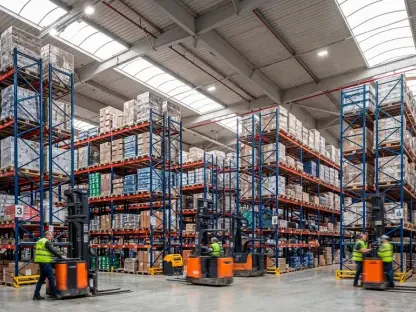In an era where online shopping has surged to unprecedented levels, with global e-commerce sales reaching over $5.5 trillion annually, the pressure on postal services to deliver efficiently has never been greater, creating a pressing need for systems to adapt. This staggering growth in digital transactions demands speed, reliability, and transparency in an increasingly connected world. Digital innovations are revolutionizing traditional mail services, transforming how parcels are sent, tracked, and received. This analysis explores the rise of digital postal tools, their real-world applications, industry perspectives, future possibilities, and key insights into how these advancements are shaping the postal landscape.
The Rise of Digital Tools in Postal Services
Growth and Adoption Trends
The adoption of digital solutions in postal services has seen remarkable growth, driven by the exponential increase in parcel volumes due to online shopping. Industry reports indicate that parcel delivery volumes in the UK alone have risen by over 30% in the past few years, with digital tracking and mobile apps becoming essential tools for both customers and providers. A significant portion of users now relies on online platforms for scheduling deliveries or monitoring shipments, with adoption rates for digital postal services climbing steadily.
This trend reflects a broader global shift toward integrating technology into postal operations. Studies show that in the UK market, over 60% of customers have used mobile apps for tracking or managing deliveries, a clear sign of how integral these tools have become. As postal services continue to digitize, the focus remains on enhancing user experience while managing the logistical challenges of increased demand.
The momentum behind digital adoption is also fueled by the need for transparency and accountability. With consumers expecting real-time updates on their parcels, postal providers are investing heavily in systems that offer seamless communication through digital interfaces. This ongoing transformation underscores the critical role technology plays in meeting modern expectations.
Real-World Applications and Impact
A prime example of digital innovation in action is the expansion of digital proof of posting services to include international parcels in the UK. Customers can now use a dedicated mobile app to send smaller international shipments via an extensive network of over 115,000 postboxes, receiving instant confirmation through barcode scanning and GPS location services. This eliminates the need to visit a physical post office, saving time and effort.
The service supports a range of international shipping options, such as tracked and signed deliveries, catering to diverse customer needs. Additionally, for larger parcels, the rollout of 3,500 solar-powered ‘postboxes of the future’ across the UK demonstrates a commitment to accessibility and sustainability. These advanced drop-off points are designed to handle increased volumes while reducing environmental impact.
The impact of these innovations is evident in the enhanced convenience for users, especially small businesses and individuals sending items abroad. With postboxes located within half a mile of 98% of UK addresses, dropping off a parcel has become as simple as a short walk. This strategic infrastructure, combined with digital tools, ensures that postal services remain relevant in a fast-paced, tech-driven society.
Industry Perspectives on Digital Postal Advancements
The value of digital postal tools is widely recognized by industry leaders, who see them as a cornerstone of modern service delivery. Jack Clarkson, Managing Director of Out of Home and Commercial Excellence at Royal Mail, has emphasized the importance of combining digital receipts with the ease of local drop-offs. According to Clarkson, the ability to post a parcel effortlessly at a nearby location while receiving immediate confirmation boosts customer confidence significantly.
Broader industry opinions echo this sentiment, highlighting how digital solutions streamline operations and improve transparency. Thought leaders in the postal sector point out that app-based tracking and proof of posting reduce disputes over lost or delayed shipments, fostering trust between providers and consumers. However, some experts caution that challenges like data privacy concerns and the digital divide must be addressed to ensure equitable access to these advancements.
Another perspective focuses on operational efficiency, with analysts noting that digital tools help postal services manage peak seasons more effectively. By automating processes like confirmation and tracking, providers can allocate resources more strategically, reducing bottlenecks. These insights collectively underscore the transformative potential of digital innovations, balanced against the need for careful implementation to mitigate risks.
Future Horizons for Digital Postal Innovations
Looking ahead, the evolution of digital postal services is expected to accelerate with wider adoption of app-based solutions and integration with smart technologies. Innovations such as artificial intelligence for route optimization and Internet of Things devices for real-time parcel monitoring could become standard, enhancing efficiency across the board. The potential for these advancements to reshape customer interactions with postal systems is immense.
The expansion of sustainable infrastructure, like solar-powered postboxes, is also likely to gain traction, aligning with global efforts to reduce carbon footprints. Benefits include improved customer satisfaction through accessible drop-off points and scalability to handle high-demand periods like the holiday season. Yet, challenges such as cybersecurity risks and the need for universal technology access could pose hurdles, requiring robust strategies to safeguard data and bridge gaps in digital literacy.
On a global scale, these innovations have the potential to redefine international shipping and e-commerce logistics. As digital tools enable faster, more reliable cross-border deliveries, postal networks worldwide may see increased collaboration to standardize systems. This could lead to a more interconnected and efficient global postal ecosystem, ultimately benefiting businesses and consumers navigating the complexities of international trade.
Key Takeaways and Forward-Looking Insights
Reflecting on the journey of digital postal innovations, it is evident that initiatives like the expansion of digital proof of posting for international parcels mark a pivotal moment in modernizing services. The vast network of over 115,000 postboxes and nearly 24,000 parcel points in the UK stands as a testament to a commitment to convenience and reliability. These developments prioritize user needs, ensuring that sending parcels, whether locally or globally, is seamless and trustworthy.
The focus on digital tools proves to be a game-changer, particularly for small businesses and individuals who rely on efficient postal solutions. By integrating technology with accessibility, postal services not only meet contemporary demands but also set a foundation for future growth. This balance of innovation and practicality highlights the sector’s adaptability in a rapidly changing landscape.
Moving forward, stakeholders are encouraged to invest in scalable digital infrastructure and address challenges like cybersecurity to sustain this momentum. Exploring partnerships for global standardization and prioritizing inclusive access to technology emerge as critical next steps. These actions promise to further elevate the postal experience, ensuring that the benefits of digital innovation reach every corner of society.









